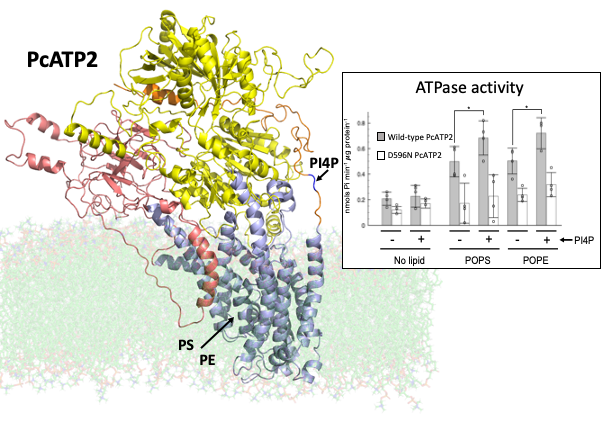Malaria, a disease caused by parasites of the genus Plasmodium, is a global health problem with a high mortality rate, especially in children. According to the WHO, malaria is responsible for nearly one million deaths per year worldwide. About 40% of the world's population is exposed and 500 million clinical cases are observed each year. Current treatments could become less effective, or even ineffective, due to the development and rapid spread of strains of Plasmodium that become drug resistant to the anti-malarial drugs classically used. It is therefore urgent to identify new therapeutic targets in order to develop new treatments.
Recent work, based on "gene targeting" approaches, has revealed that transporters of the P4-ATPase family are potential candidates for drug targeting due to their essential role in the parasite. P4-ATPases, also known as flippases, are membrane lipid transport proteins involved in maintaining lipid asymmetry between the two "layers" of cell membranes.
In this work, the researchers chose to study ATP2, a Plasmodium flippase whose function has never been characterized and which is a potential target of two antimalarial drugs. To do so, they used a recombinant ATP2 from Plasmodium chabaudi, PcATP2 produced in the yeast S. cerevisiae. They showed that PcATP2 forms heterodimers with two of the three Cdc50 subunits present in the parasite genome (Cdc50 proteins are essential partners of the P4-ATPases, responsible for addressing the complex to the right membrane location and for its functional activity). ATPase activity assays identified two potential physiological substrates of PcATP2: phosphatidylserine and phosphatidylethanolamine, and showed up-regulation by phosphatidylinositol 4-phosphate, a lipid known to play an indispensable role during intra-erythrocytic development of Plasmodium falciparum.

3D structural model of PcATP2 based on the Cryo-EM structures of the yeast and human flippases, Drs2p and ATP8A1, respectively. The 3D structural model is embedded in a membrane (green sticks). The cytoplasmic domains involved in ATP binding and autophosphorylation are in yellow, and the cytoplasmic domain involved in protein dephosphorylation in red. The C-terminal end potentially involved in protein autoinhibition is depicted in orange. Arrows indicate the position of the predicted substrate-binding pocket of phosphatidylserine (PS) and phosphatidylethanolamine (PE) phospholipids, as well as the putative binding region of PI4P. ©JL Vazquez-Ibar/CNRS
This is the first biochemical characterization of a Plasmodium flippase, thus a first step towards the understanding of the essential physiological role of this transporter and towards its validation as a potential target for anti-malarial drugs.
Contact : jose-luis.vazquez-ibar@i2bc.paris-saclay.fr